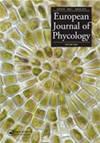空气传播物种vinatzeri Tetracystis(绿藻科,衣藻科)的pH耐受范围
IF 1.7
4区 生物学
Q2 MARINE & FRESHWATER BIOLOGY
引用次数: 0
摘要
摘要采用18S核糖体DNA基因(18S)和线粒体细胞色素c氧化酶I亚基(COI)对两株经空气采集的绿微藻进行了条形码鉴定,研究了其在酸性到碱性梯度下的生存能力。遗传指纹鉴定证实了菌株的身份,代表同一生物物种。vinatzeri对pH值的耐受性的研究完善了其生态位的划分。vinatzeri在pH为4.3-9.6的淡水生境中生长最佳,菌株可以适应稍强的酸性(低至3.8)和碱性(高至10.4)条件。然而,暴露于pH < 3和> 11时,生物体存活受到严重影响。形态学观察表明,紫斑霉能较好地适应酸性环境,对细胞膜的损伤较小。遗传分析表明,这两种空气传播的菌株具有相同的单倍型,这表明它们要么起源于相同的气团,要么单倍型分布广泛。需要进一步的系统地理学和生理学研究来确定vinatzeri的传播动态。vinatzeri可以在pH值为3.8-10.4的环境中生长。来自不同生境的菌株表现出性相容性。低遗传多样性和世界性分布表明分布广泛。关键词:绿藻分散生态学微藻存活致谢:流式细胞术在丹麦奥胡斯大学FACS核心设施进行。作者感谢A. Champeau对手稿的校对。披露声明作者未报告潜在的利益冲突。以下补充材料可通过文章在线页面https://doi.org/10.1080/09670262.2023.2260444Supplementary上的补充内容选项卡访问。紫紫四囊藻叶绿素和藻胆素(藻红蛋白和异藻蓝蛋白)的色素谱。补充图S2。叶绿素色素和大小分数的细胞信号分布,按pH类型分布:酸性(A, pH 1-4),中性(B, pH 7-9)和碱性(C, pH 10-13)。叶绿素(红色)和碘化丙啶(蓝色,死细胞)的阳性信号。作者的贡献。课程:原创概念、文化实验、数据分析、稿件撰写、编辑;S. silverver:分子数据,编辑手稿。数据可用性声明基因序列在GenBank中可用于18S (OQ402668-OQ402669)和COI (OQ412808-OQ412809)标记。S3MWC-21和S3MWC-29菌株存放于挪威藻类培养收藏(NIVA-CHL 196和NIVA-CHL 197)。本研究和S.T.由欧盟地平线2020研究与创新计划根据Marie Skłodowska-Curie资助协议提供资金。[754513]和奥胡斯大学研究基金会。S.S.由爱沙尼亚研究委员会资助[PSG735]。本文章由计算机程序翻译,如有差异,请以英文原文为准。
The pH tolerance range of the airborne species Tetracystis vinatzeri (Chlorophyceae, Chlamydomonadales)
ABSTRACTTo decipher the dispersal range of the cosmopolitan green microalga Tetracystis vinatzeri, two airborne-collected strains were barcoded using the 18S ribosomal DNA gene (18S) and the mitochondrial cytochrome c oxidase I subunit (COI), and their survival capacities were investigated across a stepwise acidic to alkaline pH gradient. Genetic fingerprinting confirmed the identity of the strains as representing the same biological species. Investigations of the tolerance of T. vinatzeri to pH levels refined the delimitation of its ecological niche. T. vinatzeri showed optimal growth in freshwater habitats at pH 4.3–9.6 and strains could cope with exposure to slightly more acidic (down to 3.8) and alkaline (up to 10.4) conditions. However, organismal survival was drastically affected by exposure to pH < 3 and > 11. Morphological observations showed that T. vinatzeri could better cope with exposure to acidic pH, exhibiting less cell membrane damage. Genetic analysis showed that the two airborne strains shared the same haplotype, suggesting that they either originated from the same air mass or that the haplotype has a widespread distribution. Further phylogeographic and physiological investigations are required to define the spreading dynamic of T. vinatzeri.Highlights Tetracystis vinatzeri can grow at pH from 3.8–10.4.Strains from different habitats showed sexual compatibility.Low genetic diversity and cosmopolitan distribution suggest widespread dispersal.KEYWORDS: Chlorophyceaedispersalecologymicroalgaesurvival AcknowledgementsFlow cytometry was performed at the FACS Core Facility, Aarhus University, Denmark. The authors are grateful to A. Champeau for proofreading the manuscript.Disclosure statementNo potential conflict of interest was reported by the author(s).Supplementary informationThe following supplementary material is accessible via the Supplementary Content tab on the article’s online page at https://doi.org/10.1080/09670262.2023.2260444Supplementary fig. S1. Pigment profile of Tetracystis vinatzeri for chlorophyll and the phycobilins (phycoerythrin and allophycocyanin).Supplementary fig. S2. Cell signal distribution for chlorophyll pigment and size fraction,distributed by pH category: acid (A, pH 1-4), neutral (B, pH 7-9), and basic (C, pH 10-13).Positive signal for chlorophylls (red) and propidium iodide (blue, dead cells).Author contributionsS. Tesson: original concept, culture experiment, data analysis, drafting and editing manuscript; S. Sildever: molecular data, editing manuscript.Data availability statementGenetic sequences are available in GenBank for both 18S (OQ402668-OQ402669) and COI (OQ412808-OQ412809) markers. S3MWC-21 and S3MWC-29 strains are deposited at the Norwegian Culture Collection of Algae (NIVA-CHL 196 and NIVA-CHL 197).Additional informationFundingThis research and S.T. are funded by the European Union’s Horizon 2020 Research and Innovation Programme under the Marie Skłodowska-Curie grant agreement no. [754513] and The Aarhus University Research Foundation. S.S. is funded by the Estonian Research Council grant [PSG735].
求助全文
通过发布文献求助,成功后即可免费获取论文全文。
去求助
来源期刊

European Journal of Phycology
生物-海洋与淡水生物学
CiteScore
4.80
自引率
4.20%
发文量
37
审稿时长
>12 weeks
期刊介绍:
The European Journal of Phycology is an important focus for the activities of algal researchers all over the world. The Editors-in-Chief are assisted by an international team of Associate Editors who are experts in the following fields: macroalgal ecology, microalgal ecology, physiology and biochemistry, cell biology, molecular biology, macroalgal and microalgal systematics, applied phycology and biotechnology. The European Journal of Phycology publishes papers on all aspects of algae, including cyanobacteria. Articles may be in the form of primary research papers and reviews of topical subjects.
The journal publishes high quality research and is well cited, with a consistently good Impact Factor.
 求助内容:
求助内容: 应助结果提醒方式:
应助结果提醒方式:


